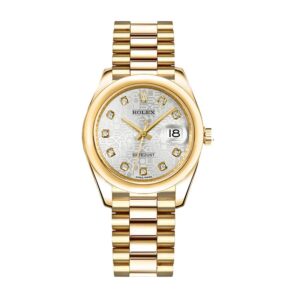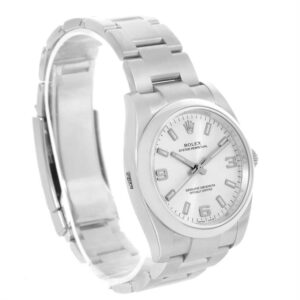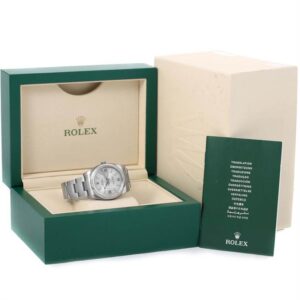The Evolution of the Rolex Air-King Tribute to Aviation
The Rolex Air-King holds a unique place in the brand’s storied history. Often overlooked as an “entry-level” model, it has quietly carved out its own legacy as one of Rolex’s longest-running watches. Born in 1945 as a tribute to British Royal Air Force (RAF) pilots, the Air-King has evolved from a modest watch into a modern sports replica watch, blending tradition with innovation. While it may not fit the mold of a traditional pilot’s watch, its understated elegance and historical significance make it a standout in Rolex’s lineup. 
Origins: A Salute to the RAF
The Air-King was part of a broader series of “Air” models, including the Air-Lion, Air-Tiger, and Air-Giant, all created to honor the RAF. While the latter three faded into obscurity, the Air-King endured, becoming the sole survivor of the series. Its early designs shared similarities with other Rolex models, such as the Milgauss and Oyster Perpetual, often differing only in dial details. The Air-King’s initial purpose was not to serve as a functional pilot’s watch but rather as a symbolic tribute to the bravery of wartime aviators.
The Early Years: Hand-Wound Beginnings (1945-1953)
The first Air-King, reference 4925, debuted in 1945 with a 34mm stainless steel Oyster case, a screw-down crown, and 50 meters of water resistance. Its dial featured an eggshell background with gold Arabic numerals and a simple track of applied dots. Powered by the hand-wound Aegler calibre 10.5, it was a no-frills, reliable watch.
Around the same time, reference 4365 introduced a small seconds sub-dial, offering a distinct alternative to the central seconds design. This variation was shared with other “Air” models, highlighting replica Rolex’s experimental approach during this era. By 1946, reference 4499 refined the design with black indices and improved legibility, marking a step toward the Air-King’s future identity.
The Transition to Automatic: Reference 6552 (1953-1957)
The introduction of reference 6552 marked a significant shift. It was the first Air-King to feature an automatic movement, the in-house calibre 1030. This movement, with its butterfly rotor and 25 jewels, represented Rolex’s commitment to precision and innovation. The dial also saw updates, including faceted “spear” indices and Arabic numerals at 3, 6, and 9 o’clock, foreshadowing the Explorer’s iconic design. 
The Modern Air-King: Reference 5500 (1957-1989)
Reference 5500 defined the Air-King for over three decades. With its 34mm case, simple baton indices, and time-only dial, it became the quintessential Air-King. Powered by calibres 1520 or 1530, it offered reliable performance without the frills of a chronometer certification. This reference also saw the introduction of corporate dials, where companies like Domino’s Pizza and Levi’s added their logos, making these models highly collectible today.
The Contemporary Era: References 14000 and 114200 (1989-2014)
The 1990s brought modern upgrades. Reference 14000 introduced a sapphire crystal and the calibre 3000 movement, while reference 114200 expanded dial options with colors like green, blue, and salmon. These models retained the Air-King’s classic 34mm case but added contemporary touches, such as Chromalight lume and refined baton hands.
The Modern Sports Watch: References 116900 and 126900 (2016-Present)
The Air-King’s most dramatic transformation came in 2016 with reference 116900. It adopted a 40mm case, Mercedes hands, and a bold dial inspired by Rolex’s dashboard instruments for the Bloodhound SSC supersonic car. The latest reference, 126900, further refined the design with a crown guard, a Parachrom hairspring, and the advanced calibre 3230 movement. While these updates elevated the Air-King to a high-end sports watch, they also distanced it from its traditional roots.
Collectibility and Affordability
One of the Air-King’s greatest appeals is its accessibility. Early references like the 5500 can be found for under $3,000, offering an affordable entry into vintage clone Rolex ownership. Rare variants, such as the “double red” dials or corporate logo models, command higher prices but remain relatively affordable compared to other vintage Rolexes. 
The Rolex Air-King has undergone a remarkable evolution, from a humble tribute to RAF pilots to a modern sports copy watch. While its latest iterations may diverge from its classic identity, they showcase Rolex’s ability to innovate while honoring its heritage. For collectors and enthusiasts, the Air-King offers a unique blend of history, affordability, and timeless style, ensuring its place in the pantheon of iconic Rolex models. Whether you prefer the simplicity of a vintage 5500 or the boldness of a modern 126900, the Air-King remains a testament to Rolex’s enduring legacy.